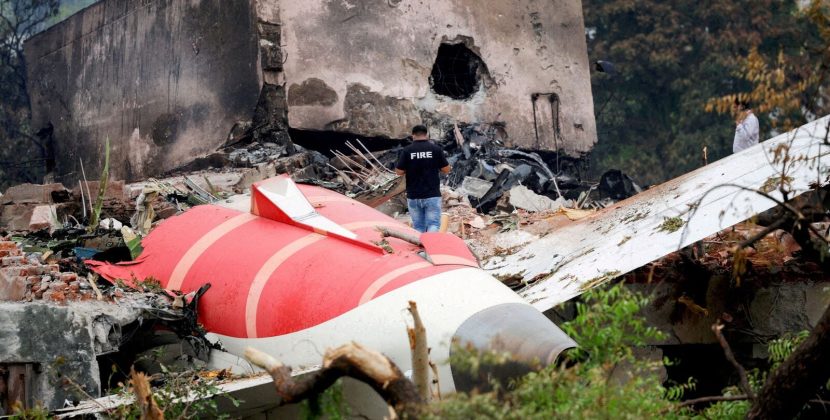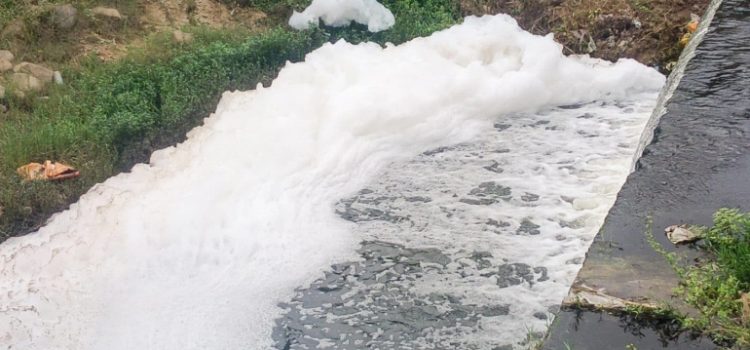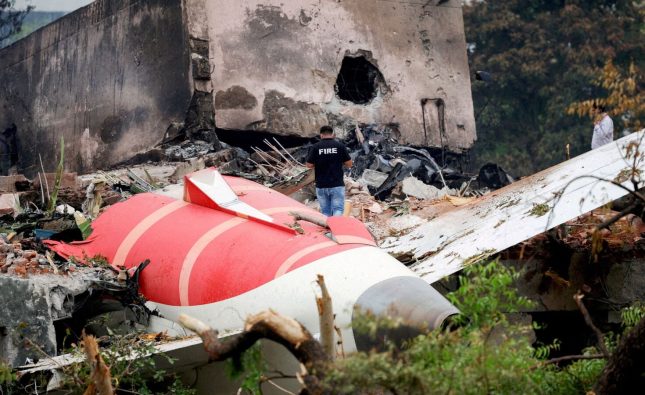
Tamil Nadu’s tanneries endanger rivers, agriculture and people, as Supreme Court ruling offers some hope
Polluted water from the Palar River flows into a field in the Ambur area of south India’s Tamil Nadu. Activists say the rising foam is due to waste discharged by the state’s numerous tanneries (Image: Varsha Torgalkar)
The Palar River flows 222 kilometres through Tamil Nadu before draining into the Bay of Bengal near Chennai. A vital drinking water source for 50 villages and 30 towns, it sustains farmland and supports India’s thriving tanneries – where animal hides and skins are turned into leather.
In return, the tannery industry is polluting the river, and the drinking water and farmland of local communities.
A landmark ruling by India’s Supreme Court in January held tanneries in Vellore district accountable for causing “irreversible damage” to water bodies, groundwater and agricultural lands.
In the river basin alone, 449 tanneries contribute around 35% of India’s leather export earnings, generating about INR 15 billion (USD 172 million) annually and employing 50,000 people. These tanneries discharge an estimated 20 million litres of effluent each day, much of it untreated, and 100,000 tonnes of salt each year. As many of them supply leather to international markets, the pollution has global as well as local implications.
N. Gajapathy, a petitioner from civil society group the Vellore Citizens Forum, played a part in the prolonged legal battle against the local industry. “We demanded adequate compensation for those who lost their lives, crops, vegetation, trees, agricultural land, wells, and suffered severe hardships due to the irresponsible and negligent act[ions] of polluting tanneries,” he says.
When the Supreme Court agreed in January this year, it ordered the Tamil Nadu government to compensate affected families, and to recover the costs from the tanneries in accordance with the “polluter pays” principle. It also ordered various measures be implemented to stop the discharge of untreated effluents.
“The tanneries, by discharging untreated or partially treated effluents into the River Palar and surrounding areas, have resulted in irreversible damage to the water bodies, groundwater and agricultural lands,” the judgment stated. “This environmental degradation has impoverished local farmers and caused human suffering to the residents and the tannery workers, endangering public health and life.”
.jpg)
An activist tests water from the Palar River for total dissolved solids, a general measure of water quality. Readings indicate high levels of pollution, especially from salts (Image: Varsha Torgalkar)
The court mandated the creation of an environmental commission to oversee compliance of its ruling. According to Amit Gupta, the Supreme Court lawyer representing the Vellore Citizens Forum, the commission has already begun surveys to assess the damage suffered by local communities.
Environmental activists believe the authority tasked with tackling this kind of pollution – the Tamil Nadu Pollution Control Board (TNPCB) – has been inadequate in its enforcement. They will be watching the new commission closely.
The TNPCB does not take action against tanneries that violate environment norms, said Gajapathy, who is from Vellore. “It only sends ‘show-cause notices’ [effectively legal warnings] to tanneries,” he tells Dialogue Earth. “But no strict action is taken. If the TNPCB was serious, tanneries would not be causing so much pollution.”
Dialogue Earth made several attempts to contact the TNPCB for comments regarding this article, including visiting the office in Tamil Nadu, but got no official response.
‘Once a beautiful lake’
Many residents hold little hope that the long-term effects of pollution can be reversed. Mani Visagam, 55, is a former trade-union leader. He reminisces about Nehru Nagar, his home town on the Palar River’s northern bank in Ranipet district, another tannery hub next to Vellore.
Thirty years ago, we had beautiful lakes and rivers. Now, they are filled with toxic waste.
The water that once sustained us has turned into poison
– Mani Visagam, former trade-union leader
“Thirty years ago, we had beautiful lakes and rivers. Now, they are filled with toxic waste. The water that once sustained us has turned into poison,” says Visagam, who now heads the local Palar River Protection Forum.
Farmers like Raghu Kanan in Vaniyambadi village, just 10km away from the cluster of tanneries that dominate the area, says the pollution crisis is ruining livelihoods. The tanneries use large amounts of salt to preserve raw hides and skin before they are processed.
“The water salinity here is extremely high,” Kanan explains. “I cultivate bananas and coconuts. Earlier, my production was high in quality and quantity, but that’s no longer the case. I survive for now, but I don’t see that happening in the future.”
He says his paddy cultivation has dropped by over 60% in the past three decades. Kanan’s situation is not unique. A 2021 study found that over 15,000 hectares of land in the region is affected by high total dissolved solids. While research shows that nearly 11,000 hectares of previously fertile farmland has lost its productivity.
“Poor germination, stunted growth, low grain yield and reduced quality have become common issues. Even the coconut water has turned saline and the nuts have shrunk,” Kanan adds.
.jpg)
Activists say this agricultural land in Ranipet has become barren due to pollution from nearby tanneries (Image: Varsha Torgalkar)
Until about two decades ago, another farmer from Vaniyambadi, who gave his name as Gopinath, cultivated coconut, areca nut, betel nut and rice on his 14-acre farm, earning INR 35,000-40,000 (USD 410-470) a month. Now, he earns INR 10,000-12,000 (USD 116-139) and can barely cover his costs. “The land is left infertile,” he says. “Vast agricultural land is lying without any crops and the pollution is deep into the soil. Even if we dig 10 feet deep, the water is unfit for irrigation.”
He adds that with few alternatives, many farmers feel forced to work in the leather industry “to the detriment of our health and our environment.”
Elango Lakshmanan, a retired professor of hydrogeology at Anna University in Chennai, explains how the pollution spreads. “Contaminated water percolates into groundwater and then flows into the river. That’s why [the polluted] water appears pinkish or brownish. Farmers use this polluted groundwater for irrigation, leading to chemicals entering the food chain,” he says.
“Too much sodium is harmful for the health of both plants and human. Sodium and fluoride affect growth of plants. When human beings consume these vegetables, they get affected. Humans and plants cannot tolerate [too much] fluoride.”
Regulatory failures and legal challenges
Under India’s Environment (Protection) Act of 1986, industries are prohibited from discharging pollutants or handling hazardous substances beyond prescribed limits.
Tamil Nadu has 13 centralised tannery waste-treatment plants. While some private companies have their own treatment plants, the majority of treated tannery waste goes through these “common” plants. They typically process between 125,000 and 250,000 litres of effluent each day, but activists say the infrastructure is inadequate and enforcement remains weak.
“Tanneries blatantly violate these provisions,” says Jaychandra, an environmental activist. His concerns are echoed by Visagam, from the Palar River Protection Forum. “Tanneries discharge untreated toxic water directly into the Palar River, especially during the monsoon, because there are no checks and no one will find out,” he says.
.jpg)
Mani Visagam heads the Palar River Protection Forum. Along with other civil society members, he has been leading the fight against the pollution of the river for more than a decade (Image: Varsha Torgalkar)
In its judgment on tannery pollution in Vellore, the Supreme Court directed authorities to identify locations where new treatment plants are required and then build them. The court also ordered existing plants be assessed for deficiencies, upgraded where necessary and properly maintained.
Sai Chaithanya, a PhD researcher at the Vellore Institute of Technology, has studied pollution in Ranipet’s tannery belt. He explained that bigger companies generally have their own treatment facilities but the majority are small- to medium-sized, and they usually do not.
Tamil Nadu’s centralised plants are connected to a monitoring system that transmits real-time data to regulatory authorities. The TNPCB oversees compliance with permitted pollutant concentrations and publishes environmental impact data on its website. Local activists allege that pollution continues unchecked despite this disclosure.
One TNPCB official, speaking on condition of anonymity, tells Dialogue Earth that the organisation acknowledges the seriousness of the tannery pollution, and that show-cause notices are often sent to tanneries for violations of effluent-discharge limits.
An environmental lawyer familiar with the issue says: “Yes, the show-cause notices are sent now and then, but after that, tanneries keep operating as usual unless and until a very serious action is taken.”
The gap between environmental policy and actual enforcement leaves residents vulnerable in such situations, the lawyer says. “There is a need for both domestic and international buyers to ensure cleaner production practices in their supply chains.”
Hydrogeologist Elango echoed these views. “European and international buyers cannot remain silent,” says Elango. “They must take responsibility for sourcing from industries that meet environmental standards, or they are complicit in the pollution here.”
Effects on health: ‘I am resigned to my fate’
In Puliyankannu village in Ranipet, 19-year-old Manuja is all too familiar with the chemical odour that fills the air.
“I am resigned to my fate and living with this pollution,” she says. Her father has been battling asthma for the last two years, and it’s getting worse. She helps support the family by working in a shoe factory near her home.
Chaithanya’s research reveals the scale of the crisis. He found elevated metal pollution in lake water, sediment and plant samples around Ranipet. This was partly because at night people would sometimes dump barrels of wastewater into it.
“We heard this from residents living on both sides of the river,” he says. “I have identified significant chromium levels in soil, water, vegetation and even animals. This contamination not only disrupts ecosystems but also enters the food chain, eventually reaching humans.”
A separate 2024 study on groundwater in Vellore supports Chaithanya’s findings, revealing alarming levels of heavy metals. Researchers assessed 140 groundwater samples, all of which exceeded pollution thresholds, indicating “extremely high health risks”.
A. Kabilan, a senior medical practitioner in Ranipet, sees the impact first hand. “The contamination caused by untreated industrial waste, chemicals and heavy metals has led to widespread health problems, affecting children and the elderly,” he says. “Even people who are not working in tanneries bear the consequences. Contaminated water used for drinking affects those with weak immune systems, from children to people with pre-existing conditions.”
Chromium, a key component in leather processing, is among the most dangerous contaminants. Raw hides are treated with chromium III, giving rise to an intermediate product called “wet blue”. Under certain conditions, such as exposure to high temperatures or oxidising agents occurring during the manufacturing processes, wet blue converts to chromium VI, which is carcinogenic. Chromium VI has been detected in leather products from Tamil Nadu at levels exceeding legal limits. Scientific research has consistently shown that inhalation of chromium VI is harmful to human health, contributing to respiratory diseases, skin ulcers, kidney malfunction and even lung cancer.
In polluted areas, chromium VI levels in water can reach 3000-3500 mg/litre, well above the safe limit of 50 mg/litre. This means that drinking water is also contaminated. “The wastewater mostly goes into the water and village soil. That’s what we drink at home,” says Raja, a resident in Santhipuram, a village on the banks of the Palar River.
Raja, who also works in a tannery in Walajapet, says he suffers from respiratory problems, while his daughter, 16, has developed kidney stones severe enough to require surgery, forcing her to drop out of school for a year. The family says she often suffers from severe abdominal pain. “The doctors said that it is due to contaminated drinking water,” Raja alleges.
Are rules set by the pollution authority being followed?
The Supreme Court ruling is not the first attempt at compensatory justice in Tamil Nadu. The Loss of Ecology Authority (LEA), a government body formed to address environmental damages, compensated Tamil Nadu farmers for water pollution caused by tanneries between 1998 to 2005. However, no compensation has been granted since then, and the LEA was dissolved in 2016. The recent Supreme Court ruling brings new, cautious hope.
The TNPCB official admits there will be no quick fix. “The department is acting, but the pollution has been going on for decades and cannot be changed within a night. This will take a long time,” they tell Dialogue Earth.
Back in his village, Raja is aware of the Supreme Court ruling, but he holds little hope for justice for his family.
“Even if compensation is paid, do those who have lost their health ever get it back?”
Authors: Varsha Torgalkar, Rifat Mohidin, Sofia Turati, Vittoria Torsello
This article was originally published on Dialogue Earth under the Creative Commons BY NC ND licence. Read the original article.









.jpg)


